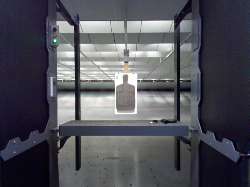by Ian A. Reeves, AIA | Vice President | Architects Design
and
Jean Pierre LeBlanc | Research Coordinator | Group Research Coordinator – Center for Public Safety
*This article first appeared in the Spring 2011 issue of Florida Police Chief Magazine and has been republished with their consent.
Editor’s Note: It seems as if anything related to firearms is controversial. If you want to sell, carry, train with, or build a shooting range, you will always be confronted with some type of challenge. Therefore, it is vital that when key information becomes available to help navigate the complexities and minutia of firearms-related issues, it be passed on through multiple mediums to further educate us all. We know this information is important and our subscribers would appreciate it, which is why Action Target has chosen to republish this article in our own weekly newsletter, The Action Target Journal.
One of the primary factors in the consideration of any new Law Enforcement or Public Safety facility is the necessity to identify a funding source, or as is true in most cases, a variety of funding sources. In essence, it is important to not only qualify a project’s spatial needs, but to also provide meaningful information as to how a project can be funded.
Assistance, in this regard, can generally be provided by City/County staff, either a Budget or Finance Director, or by City/County Administration. The more you can assist them in this endeavor, the greater are your chances to see your prospective project move forward.
While Federal grant funding has traditionally been rare for local facilities, the events of September 11th, coupled with the current economic expansion, created an environment which resulted in funds becoming available in a wide variety of locations. Many cities and counties, in that respect, have initiated studies in order to have appropriate documentation assembled for Federal grants. Additionally, they have contacted their respective legislative delegation members in order “to make their case.” Clearly, time becomes of the essence, as when Federal Funds become available, they will go to those that are prepared and who are situated in a geographically and politically important location.
Current Department of Homeland Security (DHS) and Federal Emergency Management Agency (FEMA) philosophy is patterned along these lines: If your community feels the need to support the premise of public safety, then it should be willing to provide the basic necessities for that to occur.
These basic necessities include:
- Buildings to work from and house equipment
- Manpower; in the form of either paid employees or volunteers
- Vehicles/Specialized Equipment
While there are a multitude of potential funding sources, such as Development Impact Fees, General Obligation Bonds, Law Enforcement Trust Funds, Franchise Fees, and Federal Legislative Requests, this article focuses on Grants which can provide some funding for the development of new Law Enforcement/Public Safety Facilities. Below is an applicable outline, including links for more information. Several of these grant programs have closed for FY 2011, but are expected to be available for FY 2012. We suggest you begin planning now, as this process requires a strategic approach that takes time to develop.
1. State Homeland Security Program (SHSP)
Funding Agency: DHS, FEMA
Forecasted Deadline: Deadline has passed, but anticipate similar deadline of 4/2012
Total Estimated Funding Available in FY 2011: $890 million
Purpose: SHSP is a core assistance program contained within the overarching Homeland Security Grant Program (HSGP). SHSP provides funds to build capabilities at the state, local, tribal, and territorial levels and to implement the goals and objectives included in state homeland security strategies and initiatives in their State Preparedness Report (SPR). Activities implemented under SHSP must support terrorism preparedness by building or enhancing capabilities that relate to the prevention from, or response to, and recovery from terrorism in order to be considered eligible.
Eligible Applicants: Applicants to SHSP are the designated State Administrative Agencies (SAAs) of each of the 50 states, the District of Columbia, Puerto Rico, American Samoa, Guam, Northern Mariana Islands, and the Virgin Islands. Available funds are distributed to each state based upon the risk and effectiveness scores associated with each application and also on a minimum allocation consistent with the statutory formula set by the Implementing Recommendations of the 9/11 Commission Act of 2007.
For More Information: https://www.fema.gov
2. Urban Areas Security Initiative (UASI)
Funding Agency: DHS, FEMA
Forecast Deadline: Deadline has passed, but anticipate similar deadline of 4/2012
Total Estimated Funding Available in FY 2011: $930 million
Purpose: The FY10 UASI program focused on enhancing regional preparedness in 64 major metropolitan areas, and the list of areas is expected to remain relatively unchanged in 2011. The UASI program directly supports expanding regional collaboration in the National Preparedness Guidelines and is intended to assist participating jurisdictions in developing integrated regional systems for prevention, protection, response, and recovery. In 2010, DHS elevated three previous Tier II areas to Tier I (Boston, Philadelphia, Houston, and the Dallas/Fort Worth/Arlington Area), bringing the Tier I area list to 10, and added two new areas (Bakersfield, Calif., and Omaha, Neb.) to Tier II.
Eligible Applicants: Applicants to UASI are the designated SAAs of each state/territory containing a UASI Area. Eligible area candidates for the UASI program are determined through an analysis of relative risk of terrorism faced by the 100 most populous metropolitan statistical areas in the United States, and funds are allocated to each area based on risk analysis and the anticipated effectiveness of proposed investments by the applicants. Similar to previous years, the FY11 program is expected to direct approximately $598 million, or 63 percent of the total funding, to the 10 highest risk urban areas (Tier I), and the remaining urban areas (Tier II) will receive approximately $352 million.
For More Information: https://www.fema.gov/government/grant/uasi/index.shtm
3. Emergency Operations Center Grant Program (EOC)
Funding Agency: DHS, FEMA
Forecast Deadline: Deadline has passed, but anticipate similar deadline of 2/2012
Total Estimated Funding Available in FY 2011: $31.5 million
Purpose: The Emergency Operations Center (EOC) Grant Program is intended to improve emergency management and preparedness capabilities by supporting flexible, sustainable, secure, and interoperable EOCs with a focus on addressing identified deficiencies and needs. Funding is intended for construction or renovation of a state, local, or tribal government’s principal EOC. Similar to FY10, it is expected that if EOC receives funding in FY11, a portion will be allocated via congressionally directed spending (earmark) and the remainder competitively awarded.
Eligible Applicants: SAAs apply for EOC funding on behalf of eligible state, local, and tribal EOCs.
For More Information: https://www.fema.gov/government/grant/eoc/index.shtm
4. Interoperable Emergency Communications Grant Program (IECGP)
Funding Agency: DHS, FEMA
Forecasted Deadline: Deadline has passed, but anticipate similar deadline of 2/2012
Total Estimated Funding Available in FY 2011: $50 million
Purpose: IECGP provides funding to states, territories, local, and tribal governments to carry out initiatives to improve interoperable emergency communications. All activities proposed under IECGP must be integral to interoperable emergency communications and must be aligned with the goals, objectives, and/or initiatives identified in the grantee’s approved Statewide Communication Interoperability Plan (SCIP). If an SAA and SCIP certify that its state or territory has fulfilled its SCIP’s governance, planning, training, and exercise objectives, the program provides the flexibility to purchase interoperable communications equipment with any remaining IECGP funds.
Eligibility: All 56 states and territories are eligible to apply for IECGP funds. SAAs are responsible for the administration of this program. SAAs are required to coordinate with the Statewide Interoperability Coordinator (SWIC) and/or SCIP point of contact to ensure IECGP program requirements are met. The SAA must obligate 80 percent of the funds awarded under the IECGP to local/tribal governments within 45 days of receipt of the funds.
For More Information: https://www.fema.gov/government/grant/iecgp/index.shtm
5. Pre-Disaster Mitigation (PDM) Grants
Funding Agency: DHS, FEMA
Forecasted Deadline: 12/01/2011
Total Estimated Funding Available in FY 2011: $75 million
Purpose: PDM is one of the FEMA Hazard Mitigation Assistance (HMA) programs. Hazard mitigation is any sustained action taken to reduce or eliminate long-term risk to people and property from natural hazards and their effects. The PDM program provides funds to states, territories, federally recognized Indian tribal governments, and communities for hazard mitigation planning and the implementation of mitigation projects prior to a disaster event.
Eligible Applicants: The state emergency management agency or a similar office (i.e., the office that has primary emergency management or floodplain management responsibility) of each state, the District of Columbia, the US Virgin Islands, Puerto Rico, Guam, American Samoa, the Commonwealth of the Northern Mariana Islands, and federally recognized Indian tribal governments are eligible to apply. Each state, territory, or tribal government designates one agency to serve as the applicant for each HMA program.
For More Information: https://www.fema.gov/government/grant/pdm/index.shtm
6. HMGP – Hazard Mitigation Grant Program
Funding Agency: FEMA/DHS
Forecasted Deadline: 12/01/2011
Total Estimated Funding Available in FY 2011: $23 million
Purpose: Authorized under Section 404 of the Stafford Act, the Hazard Mitigation Grant Program (HMGP) provides grants to States and local governments to implement long-term hazard mitigation measures after a major disaster declaration. The purpose of the program is to reduce the loss of life and property due to natural disasters and to enable mitigation measures to be implemented during the immediate recovery from a disaster declaration.
Eligible Applicants: The Hazard Mitigation Grant Program funding is only available in States following a Presidential disaster declaration. Eligible applicants are: State and local governments, Indian tribes or other tribal organizations, and certain private non-profit organizations. Individual homeowners and businesses may not apply directly to the program; however, a community may apply on their behalf. HMGP funds may be used to fund projects that will reduce or eliminate the losses from future disasters. Projects must provide a long-term solution to a problem, for example, elevation of a home to reduce the risk of flood damages as opposed to buying sandbags and pumps to fight the flood. In addition, a project’s potential savings must be more than the cost of implementing the project. Funds may be used to protect either public or private property or to purchase property that has been subjected to, or is in danger of, repetitive damage.
For More Information: https://www.fema.gov/government/grant/hmgp/index.shtm
7. CDBG – Community Development Block Grants
Funding Agency: DOA (Department of Agriculture)
Forecasted Deadline: 12/01/2011
Total Estimated Funding Available in FY 2011: $3.804 billion
Purpose: The CDBG funds may be used for activities which include, but are not limited to: acquisition of real property, relocation and demolition, rehabilitation of residential and non-residential structures, construction of public facilities and improvements, such as water and sewer facilities, streets, neighborhood centers, and the conversion of school buildings for eligible purposes, public services, within certain limits, activities relating to energy conservation, and renewable energy resources.
Eligible Applicants: Principal cities of Metropolitan Statistical Areas (MSA’s), other metropolitan cities with populations of at least 50,000, and qualified urban counties with populations of at least 200,000 (excluding the population of entitled cities) are entitled to receive annual grants. HUD determines the amount of each entitlement grant by a statutory dual formula which uses several objective measures of community needs, including the extent of poverty, population, housing overcrowding, age of housing and population growth lag in relationship to other metropolitan areas.
For more Information: https://www.hud.gov/offices/cpd/communitydevelopment/programs/
8. USDA – Rural Facilities Block Grant Program
Funding Agency: DOA
Forecasted Deadline: 12/01/2011
Total Estimated Funding Available in FY 2011: $25 million
Purpose: The Community Facilities Grant Program is typically used to fund projects under special initiatives, such as Native American community development efforts, child care centers linked with the Federal government’s Welfare-to-Work initiative, Federally-designated Enterprise and Champion Communities, and the Northwest Economic Adjustment Initiative area. In most cases, grantees are able to leverage Community Facility funds with private and state dollars to enable completion of more construction than might have otherwise been possible.
Eligible Applicants: Community Programs provides grants to assist in the development of essential community facilities in rural areas and towns of up to 20,000 in population. Grants are authorized on a graduated scale. Applicants located in small communities with low populations and low incomes will receive a higher percentage of grants. Grants are available to public entities such as municipalities, counties, and special-purpose districts, as well as non-profit corporations and tribal governments. In addition, applicants must have the legal authority necessary for construction, operation, and maintenance of the proposed facility and also be unable to obtain needed funds from commercial sources at reasonable rates and terms. Regarding Essential Community Facilities, the USDA Rural Development Community Programs has invested $1.2 billion in rural communities. Of the $1.2 billion in the loan portfolio, 33% was invested in rural health care, 12% in public services, 27% in public safety, 9% in cultural and educational facilities, and 4% in transportation services.
For More Information: https://www.rurdev.usda.gov/HCF_CF.html
10 Tips for Getting More Grants
Source: Homeland Security Today
1. Learn as much as possible about each program to which you intend to apply.
2. Involve others in your project but be judicious-have a purpose for their involvement.
3. Customize each proposal to the requirements of the funder.
4. Include only support letters that demonstrate a real commitment on the part of the sender.
5. Get reviewers’ comments for rejected proposals and use their feedback in future proposals.
6. Make grant seeking part of your agency’s strategy–don’t put all your eggs in one basket and look for funding from only a single program.
7. Be specific in your budget–most foundations have generous allowances for budget length.
8. Don’t include materials other than those specifically requested by the funder.
9. Have an outsider edit your proposal before you submit it.
10. Follow the funding guidance meticulously.
“New Age” Strategy
There are a number of things you can do to properly cope with these new challenges:
- Re-educate yourselves and your governing bodies to the new landscape that exists regarding federal funding.
- Do the research and learn what is available now for you to consider.
- Learn what the grants will or will not fund. Look at past grants to see what they funded in previous years, and match your needs to those programs.
- Set aside local match monies so that you can apply and more importantly, accept an award when you are offered a grant contract.
- Adjust your budgets to eliminate using your own funding for items that grants will supply and then re-invest those monies into capital investment funds that are managed by professional money managers. This will allow you to have a 10 year replacement program for vehicles, building improvements etc. and will let you take advantage of the miracle of compound interest.
- Stop procrastinating and quit “bellyaching” about what the other guy got and figure out what you need to do to get what you need.
- Apply! Grants are like the lotto-you can’t win if you don’t play!
While grants can provide the “seed” money to get a project initiated, very rarely will it provide necessary to complete construction of a project. There are a multiple of other funding options that should be considered for, as we know, there is not a singular source of revenue that represents a “silver bullet.”
ADG and CPS take pride in assisting our clients and colleagues in the Public Safety Community with pursuing and achieving supplemental funding for their projects. Please consider us as a resource in your pursuits of launching these important projects.
Biographies
Ian A. Reeves, AIA is the Law Enforcement Design Specialist for Architects Design Group (ADG). Mr. Reeves received his Bachelor of Architecture from the University of New Mexico and a Master of Architecture from the University of Florida. He has dedicated his architecture career to Public Safety facility design, was the project manager for the recently completed Sarasota Police Department Headquarters and the Sanford Public Safety Facility, and has served as project manager for numerous other projects among the last ten years. Mr. Reeves is a graduate of the City of Winter Parks Citizen Police Academy and the Orange County Citizens Sheriff Academy. He is a member of the International Association of Chiefs of Police Chiefs, the Florida Police Chief’s Association, and the International CPTED Association.
Jean Pierre LeBlanc joined the Center for Public Safety (CPS) as the grants researcher and coordinator. He brings a unique skill set to CPS, able to blend his years of private sector business leadership experience while working with federal government agencies. His area of expertise focuses on research and knowledge in the field of public safety grants at the state regional and federal levels for law enforcement, fire service, emergency communications, and dispatch clients. Mr. LeBlanc tracks a multitude of grants and works with ADG and CPS clients to assist them in grant awareness, applications, and management.
* The views are the authors’ own and don’t necessarily represent those of Action Target, Inc.










 Rental or lease programs are realistic possibilities, allowing for more informed decisions to be made. A singular offering like an on-site range provides a service unavailable elsewhere, meaning you are selling not only the firearms, but also a rare service–your expertise.
Rental or lease programs are realistic possibilities, allowing for more informed decisions to be made. A singular offering like an on-site range provides a service unavailable elsewhere, meaning you are selling not only the firearms, but also a rare service–your expertise. The value of simplicity, then, is clearly demonstrated. On a typical commercial range, there is no need for fancy, high-end target retrieval systems. The most cost-effective system on a range is a simple
The value of simplicity, then, is clearly demonstrated. On a typical commercial range, there is no need for fancy, high-end target retrieval systems. The most cost-effective system on a range is a simple